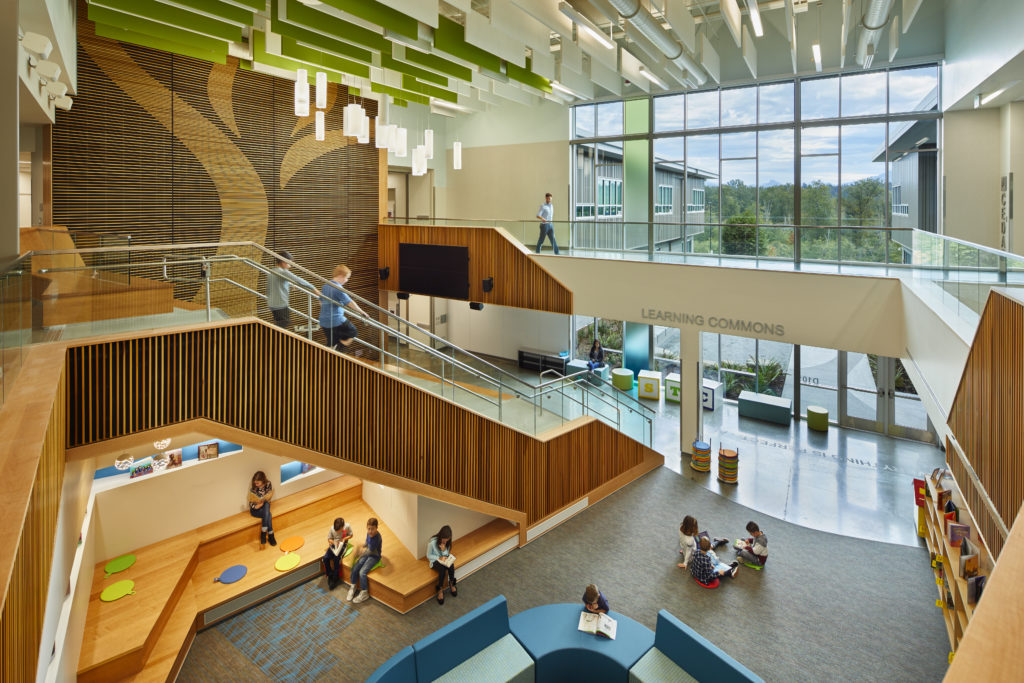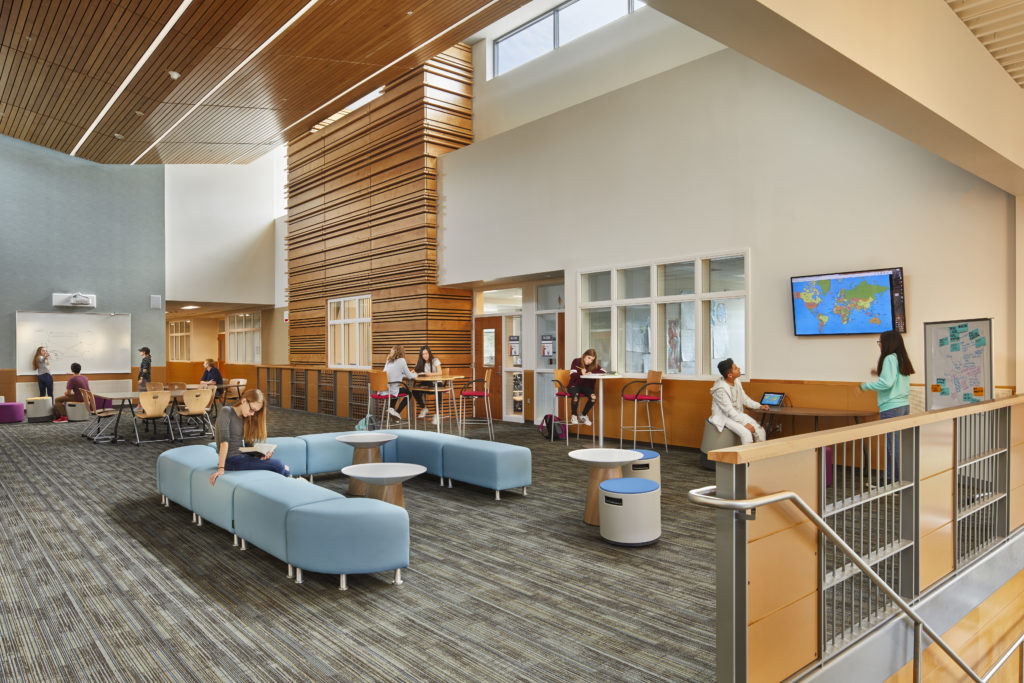
Company: NAC Architecture
Title: Principal
EDmarket Leadership Position: Board Member, Executive Committee Member
Years in the education business: 31
When was your company founded and how?
NAC Architecture’s roots date back to 1960 in Spokane, Washington. The firm expanded to Seattle in 1983, Los Angeles in 2006, and Columbus, Ohio in 2020. NAC is now 240-strong and providing planning and design services for learning and healthcare environments throughout the United States. NAC officially began in 1979 when three different Spokane architecture firms came together to pursue and win a project to replace twelve elementary schools for Spokane Public Schools. Their joint venture partnership, Northwest Architectural Company, proved successful and grew into a mission-driven firm focused on facilities supporting childhood development from early learning through 12th grade.
In 2006, NAC reached the Los Angeles market by merging with Jubany Architecture and became NAC Architecture. In 2014, another LA firm, Osborn, joined the practice. These like-minded firms, sharing a commitment to community engagement, technical acumen, sustainable innovation, and creative problem-solving, together strengthened goals for design excellence in educational, civic, healthcare, laboratory, housing, and cultural projects.

Over the years, NAC has also become a national leader in higher education design, planning, and residential life. The firm is now recognized for enriching social and academic experiences for college and university students by defining the connection between environments, academic performance, and sense of personal wellness. In 2020, NAC merged with nationally acclaimed healthcare analytics, planning, and design firm, Trinity: Planning, Design, Architecture, based in Columbus, Ohio. With collaborations stretching back more than ten years, the firms’ combined knowledge and experience means that NAC now provides even stronger client services to support its deep commitment to building healthy communities.
What makes your company unique?
NAC Architecture believes learning and healing environments are among the most important buildings in the world, not for their brick and mortar, but for the work that happens within them. We are recognized for innovative and sustainable solutions that enrich social and academic experiences and allow us to live our mission: Engaging with communities, we create places that advance learning, enhance wellness, and enrich lives. NAC works to design places that support the whole child, providing environments that promote equity in education and strengthen each student’s ability to succeed. By helping our clients better meet students’ educational requirements, we create places that support and enhance their surrounding communities.

Our founding owners instilled a culture of client advocacy, service, and design engagement that has grown the firm from a small office in Spokane, Washington to a national presence with 240 professionals in four offices across the country. Our inclusive approach enhances the critical thinking we bring to our work — developing a variety of alternative solutions to achieve goals that we establish collaboratively with the communities in which we work. We work to stay ahead of the curve when it comes to innovations that offer inspiring, collaboration-based spaces to support students’ learning needs. Our in-house Research and Experience Development (RED) director provides our teams with valuable data on the connection between the educational environment and academic performance.
What do you like best about the educational products industry?
Every year, what I observe and appreciate about the educational products industry is the constant push for new development and innovation that allows us to constantly improve our responses to pedagogical changes and clients’ needs. When manufacturers, distributors, and dealers ask us for input and then incorporate our ideas into their designs, the sense of accomplishment growing directly from our collaboration is tangible. Students, teachers, and communities all benefit from these new opportunities to create a school made just for them.
As a leader in the American Institute of Architects Committee on Architecture for Education (AIA CAE), I was in a position to help develop the AIA CAE’s successful relationship with EDmarket.
What are you most proud of?
I am proud that my career has resulted in new and renovated schools that positively impact tens of thousands of students, teachers, and members of the public every day. As a leader in the American Institute of Architects Committee on Architecture for Education (AIA CAE), I was in a position to help develop the AIA CAE’s successful relationship with EDmarket. The dynamic educational and facility tour opportunities now integral to the annual EDspaces conference are an important outcome, making me feel honored to support my industry colleagues with a legacy for ongoing learning and collaboration.
How has the pandemic changed the educational marketplace?
Our experience of the pandemic was unexpected. Schools closed or had smaller groups of students and teachers during most of 2020, which led many of our clients to accelerate architectural and facility improvement projects. Initially, the leaders in our firm braced for our work being put on hold, but instead we found that projects already in design sped up to allow construction to occur while students were learning from home. 2020 ended up being our busiest year ever. As we move into the second half of 2021, we are starting to see a significant decline in new educational facility projects that is balanced by a new focus on improved ventilation and sanitary systems, along with overall school security.
Not surprisingly, virtually all school construction bonds in the Northwest were postponed, while in southern California, a large bond that passed just prior to the pandemic resulted in major school facility projects moving forward in that region. Thankfully, as schools are reopening in the Northwest, school districts are considering placing construction bond measures on the ballot in 2022 to address overcrowding and aging infrastructure. In addition, the ability to effectively work remotely has led many families to move into the outlying towns where we work, resulting in the need for more school capacity in these communities.
How has your company adapted?
All four of our offices adapted readily to a hybrid work environment, thanks to the talent and dedication of our IT professionals. Within a couple of weeks, all 240 of our employees were able to work from home, while remaining in close contact electronically. In turn, our new virtual world presented the chance for us to increase cross-office teaming— bringing the best expertise and experience to each project.
One example of virtual collaboration benefitting NAC is how we completed the design of several new replacement schools by drawing on skillsets not only from Seattle, but also from our Spokane and Columbus offices. Taking a laptop to socially distanced in-person client meetings meant that we could include key team members via Zoom or Facetime to facilitate selection of exterior and interior finish materials from physical samples. We were pleased to discover that this approach was quite effective and allowed the client’s design review committee to see materials in a variety of interior and exterior lighting conditions.
How had EDmarket helped your business?
As an architect and planner of educational facilities, I have found the collaboration occurring between EDmarket and the AIA CAE each year at EDspaces an excellent opportunity for architects and interior designers to expose their clients to new ideas.

Vera Risdon Middle School is an example of the kind of success that comes from manufacturers having the chance to interact with the people who use their products every day. At the start of the project, we took the design committee on tours of schools in local districts to see how other architects and educators had responded to their students’ learning needs. The principal was so impressed by how another school was using shared learning spaces outside classroom clusters that he went back to his school, moved the outdated furniture out, and purchased new furniture designed to allow groups of students to collaborate more effectively.
In 2019, we brought our La Center Middle School client to the EDspaces event in Milwaukee. They were able to explore possibilities for equipping their new school that they had never imagined before and left feeling excited to continue their visioning process with the design team.

With the sale of EDspaces, how can EDmarket best serve the industry?
I believe we are in a position to focus our energies on cultivating relationships not only between our members, but also with allied organizations. While our contributions to the annual EDspaces event are critical to our success, we no longer need to deal with the overall logistics of hosting the conference. Instead we can put our energy into outreach and education. An excellent example is the recent national recognition of our Essentials Magazine, winning a Communicators Design Award of Distinction from the Academy of Interactive Visual Arts (AIVA). Focusing on our outreach not only to our membership, but also to those who interact with the products and services we provide, will be critical to our ongoing growth and success.
What would you like to see EDmarket champion?
I would like to see EDmarket champion new ways to engage higher education institutions. NAC does a lot of work in the student housing market, typically through a design-build or P3 (public-private-partnership) process. Higher education institutions are continually looking for partners who can design, construct, and manage student life facilities to leverage their bonding capacity while attracting and retaining the best students. What used to be called a dormitory is now a fully functional community with cafes, fitness centers, libraries, computer labs, and associated amenity spaces to support the overall campus. I believe this is an untapped market for our membership.
Let’s continue joining forces to support successful educational outcomes going forward.
What advice would you give others in our industry?
The best advice I can give our industry is to keep innovating, thinking collaboratively, and listening for opportunities to improve the service we provide to our clients. While the circumstances of the past year came as a surprise, the challenges we encountered are prompting visions for whole new ways to enhance learning. Students and teachers of the future will live in an increasingly technological world. What might that look like? Let’s continue joining forces to support successful educational outcomes going forward.
Additionally, we should be mindful of our current supply chain issues. A combination of COVID unemployment, Canadian lumber tariffs and timber harvesting complications, along with trucking shortages and rebuilding efforts in the American southeast after catastrophic storms, has hit our industry hard. We can expect these challenges to continue into at least the first quarter of 2022.

